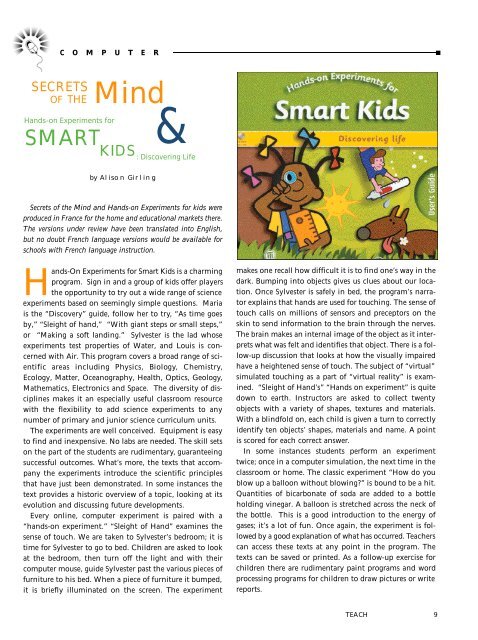Le Prof Le Prof - TEACH Magazine
Le Prof Le Prof - TEACH Magazine
Le Prof Le Prof - TEACH Magazine
You also want an ePaper? Increase the reach of your titles
YUMPU automatically turns print PDFs into web optimized ePapers that Google loves.
C O M P U T E R<br />
S EC RETS<br />
Mind<br />
OF THE<br />
&<br />
Hands-on Experiments for<br />
S M A R T<br />
K ID S : Discovering Life<br />
by Alison Girling<br />
Secrets of the Mind and Hands-on Experiments for kids were<br />
produced in France for the home and educational markets there.<br />
The versions under review have been translated into English,<br />
but no doubt French language versions would be available for<br />
schools with French language instruction.<br />
Hands-On Experiments for Smart Kids is a charming<br />
program. Sign in and a group of kids offer players<br />
the opportunity to try out a wide range of science<br />
experiments based on seemingly simple questions. Maria<br />
is the “Discovery” guide, follow her to try, “As time goes<br />
by,” “Sleight of hand,” “With giant steps or small steps,”<br />
or “Making a soft landing.” Sylvester is the lad whose<br />
experiments test properties of Water, and Louis is concerned<br />
with Air. This program covers a broad range of scientific<br />
areas including Physics, Biology, Chemistry,<br />
Ecology, Matter, Oceanography, Health, Optics, Geology,<br />
Mathematics, Electronics and Space. The diversity of disciplines<br />
makes it an especially useful classroom resource<br />
with the flexibility to add science experiments to any<br />
number of primary and junior science curriculum units.<br />
The experiments are well conceived. Equipment is easy<br />
to find and inexpensive. No labs are needed. The skill sets<br />
on the part of the students are rudimentary, guaranteeing<br />
successful outcomes. What’s more, the texts that accompany<br />
the experiments introduce the scientific principles<br />
that have just been demonstrated. In some instances the<br />
text provides a historic overview of a topic, looking at its<br />
evolution and discussing future developments.<br />
Every online, computer experiment is paired with a<br />
“hands-on experiment.” “Sleight of Hand” examines the<br />
sense of touch. We are taken to Sylvester’s bedroom; it is<br />
time for Sylvester to go to bed. Children are asked to look<br />
at the bedroom, then turn off the light and with their<br />
computer mouse, guide Sylvester past the various pieces of<br />
furniture to his bed. When a piece of furniture it bumped,<br />
it is briefly illuminated on the screen. The experiment<br />
makes one recall how difficult it is to find one’s way in the<br />
dark. Bumping into objects gives us clues about our location.<br />
Once Sylvester is safely in bed, the program’s narrator<br />
explains that hands are used for touching. The sense of<br />
touch calls on millions of sensors and preceptors on the<br />
skin to send information to the brain through the nerves.<br />
The brain makes an internal image of the object as it interprets<br />
what was felt and identifies that object. There is a follow-up<br />
discussion that looks at how the visually impaired<br />
have a heightened sense of touch. The subject of “virtual”<br />
simulated touching as a part of “virtual reality” is examined.<br />
“Sleight of Hand’s” “Hands on experiment” is quite<br />
down to earth. Instructors are asked to collect twenty<br />
objects with a variety of shapes, textures and materials.<br />
With a blindfold on, each child is given a turn to correctly<br />
identify ten objects’ shapes, materials and name. A point<br />
is scored for each correct answer.<br />
In some instances students perform an experiment<br />
twice; once in a computer simulation, the next time in the<br />
classroom or home. The classic experiment “How do you<br />
blow up a balloon without blowing?” is bound to be a hit.<br />
Quantities of bicarbonate of soda are added to a bottle<br />
holding vinegar. A balloon is stretched across the neck of<br />
the bottle. This is a good introduction to the energy of<br />
gases; it’s a lot of fun. Once again, the experiment is followed<br />
by a good explanation of what has occurred. Teachers<br />
can access these texts at any point in the program. The<br />
texts can be saved or printed. As a follow-up exercise for<br />
children there are rudimentary paint programs and word<br />
processing programs for children to draw pictures or write<br />
reports.<br />
<strong>TEACH</strong> 9



